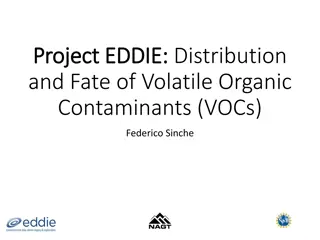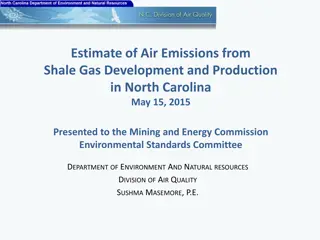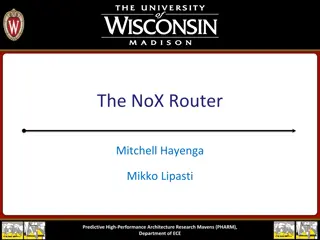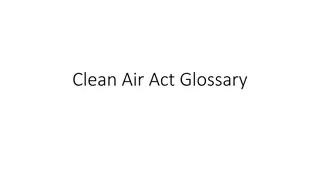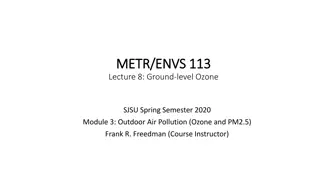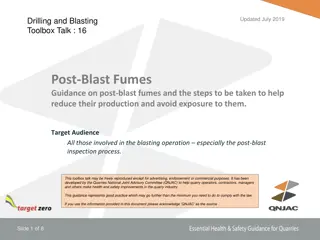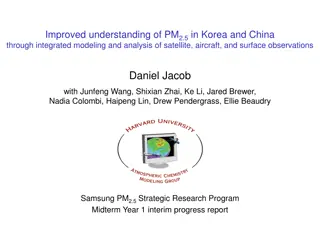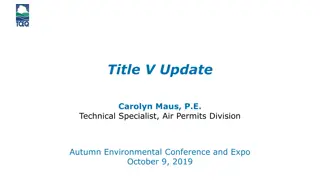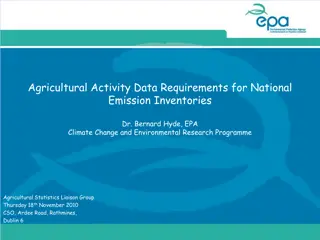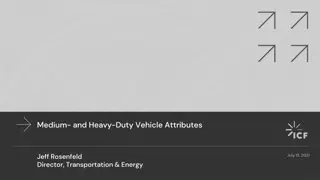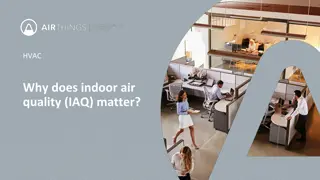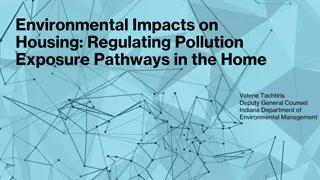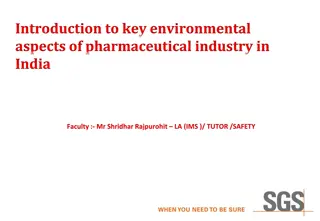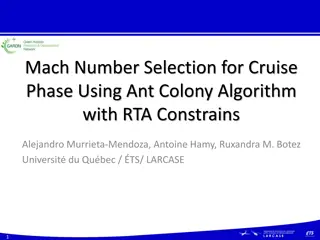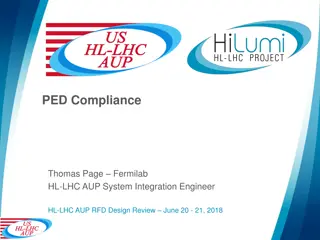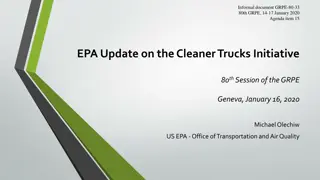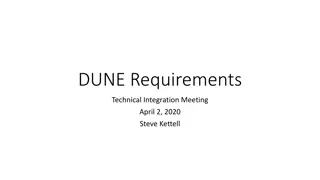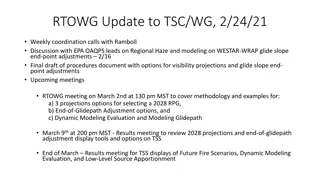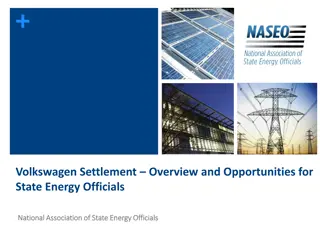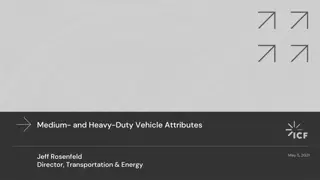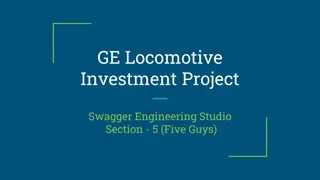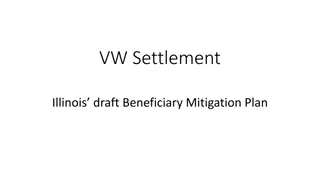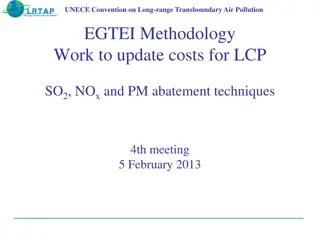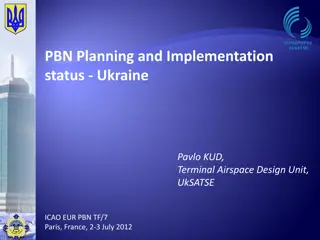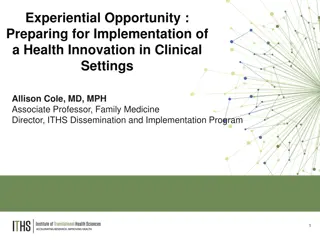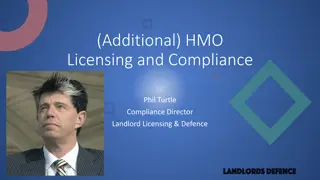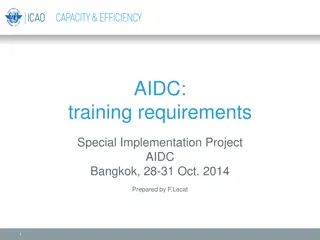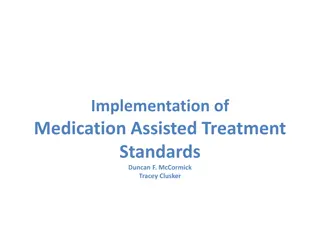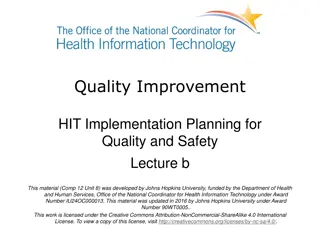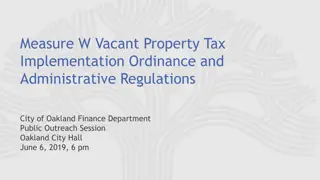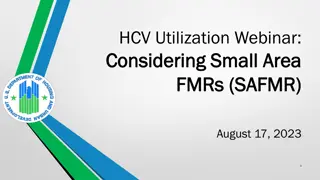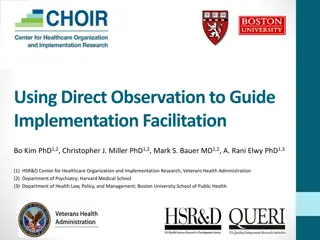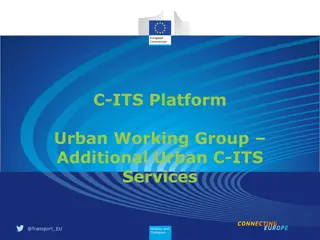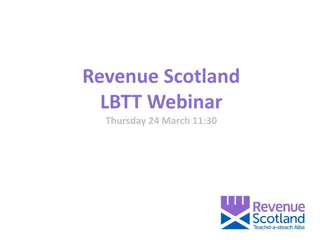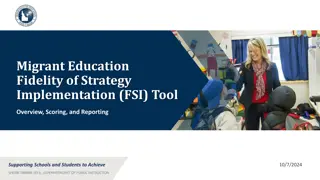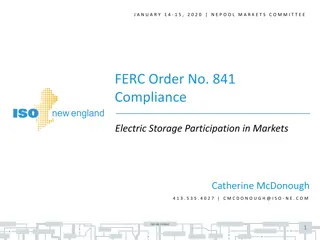Implementation of Additional RACT Requirements for NOx and VOCs
This presentation outlines the final RACT requirements for major sources of nitrogen oxides (NOx) and volatile organic compounds (VOCs) in Pennsylvania, focusing on the purpose of the RACT II rulemaking, re-evaluation of RACT due to updated ozone standards, and an overview of the definitions and regulations under the final RACT II rule. The regulations aim to implement control technologies feasibly available for emission reductions in designated areas.
Download Presentation

Please find below an Image/Link to download the presentation.
The content on the website is provided AS IS for your information and personal use only. It may not be sold, licensed, or shared on other websites without obtaining consent from the author. Download presentation by click this link. If you encounter any issues during the download, it is possible that the publisher has removed the file from their server.
E N D
Presentation Transcript
Additional RACT Requirements for Major Sources of NOx and VOCs: Final Rule (25 Pa. Code Chapters 121 and 129) RACT Overview and Implementation Presentation Patrick McDonnell, Acting Secretary Tom Wolf, Governor
Purpose of the Final RACT II Rulemaking On April 23, 2016, the Environmental Quality Board (EQB) promulgated additional reasonably available control technology (RACT) requirements for major stationary sources of nitrogen oxides (NOx) and volatile organic compounds (VOCs). (See 46 Pa. B. 2036) The definitions codified in 25 Pa. Code 121.1 and substantive provisions in 25 Pa. Code 129.96 - 129.100 are required under the Clean Air Act to implement the RACT requirements for the 1997 and 2008 8-hour ozone National Ambient Air Quality Standards (NAAQS). This final rulemaking, hereafter referred to as RACT II , was submitted to the United States Environmental Protection Agency (EPA) in May 2016 for approval as a revision to the Commonwealth s State Implementation Plan (SIP). 2
Purpose of the Final RACT II Rulemaking RACT is defined by the EPA and EQB, as the lowest emission limitation that a particular source is capable of meeting by the application of control technology that is reasonably available considering technological and economic feasibility. RACT applies to major stationary sources of NOx and VOCs in designated ozone nonattainment areas and the Ozone Transport Region. The RACT requirements promulgated in January 1994 in 25 Pa. Code 129.91 - 129.95 continue to be applicable requirements (RACT I). 3
Re-evaluation of RACT The CAA requires a re-evaluation of RACT each time EPA promulgates or revises the NAAQS for ozone. This re-evaluation of RACT is necessary because EPA revised the ozone NAAQS in 1997 and 2008. On Oct. 1, 2015, EPA promulgated a revised ozone standard of 70 parts per billion (70 ppb). A re-evaluation of RACT will be due to EPA as a SIP revision within two years from the effective date of the final designations for the 2015 ozone NAAQS.
Overview of Final RACT II Regulation Definitions 25 Pa. Code 121.1 Revised definitions include: CEMS Continuous emissions monitoring system Major NOx emitting facility Major VOC emitting facility Stationary internal combustion engine or stationary reciprocating internal combustion engine New definitions include: Process heater Refinery gas Regenerative cycle combustion turbine Simple cycle combustion turbine Stationary combustion turbine 5
Overview of Final RACT II Regulation 25 Pa. Code 129.96 Applicability 25 Pa. Code 129.97 Presumptive RACT Requirements, RACT Emissions Limitations and Petition For Alternative Compliance Schedule 25 Pa. Code 129.98 Facility-wide or System-Wide NOX Emissions Averaging Plan General Requirements 25 Pa. Code 129.99 Alternative RACT Proposal and Petition for Alternative Compliance Schedule 25 Pa. Code 129.100 Compliance Demonstration and Recordkeeping Requirements 6
Final RACT II Regulation: Applicability The RACT II regulation applies to any owner or operator of a major NOx-emitting facility or a major VOC- emitting facility, or both, that existed on or before July 20, 2012. [25 Pa. Code 129.96(a)] Note that for facilities in the southeast region, the 25 tons per year (TPY) thresholds for NOx and VOC do not apply for RACT II purposes. The statewide RACT II applicability thresholds for NOx and VOC are 100 and 50 TPY, respectively. [25 Pa. Code 121.1] Due to Clean Air Act anti-backsliding provisions, the determinations made under RACT I still apply at the 25 TPY thresholds in the 5-county Philadelphia Area. 7
Final RACT II Regulation: Applicability In accordance with 25 Pa. Code 129.96(d), an owner or operator of a facility seeking to become a minor facility for NOx and/or VOC to avoid RACT requirements must have practically enforceable emission limitations in a Plan Approval or Operating Permit issued by DEP before Jan. 1, 2017. The RACT II regulation also applies to owners or operators modifying their facility after July 20, 2012, that result in the source or facility meeting the definition of a major NOx-emitting facility or a major VOC emitting facility, or both. The modification of the facility includes construction of new sources and/or modification of existing sources. [25 Pa. Code 129.96(b)] 8
Final RACT II Regulation: Applicability Owners and operators of facilities that are major facilities solely for NOx emissions are only subject to the NOx RACT requirements. Likewise, owners and operators of facilities that are major facilities solely for VOC emissions are only subject to the VOC RACT requirements. The RACT II regulation applies as a snapshot in time. RACT is evaluated for sources located at a major facility that existed on July 20, 2012. New sources constructed after this date at a major facility are not subject to the RACT II requirements and do not require a RACT evaluation at this time. In addition to best available technology (BAT) requirements, nonattainment new source review (NNSR) may also apply to the facility. 9
Final RACT II Regulation: Applicability The RACT II regulation does not apply to the following: Sources which are subject to regulations adopted to implement Control Technique Guidelines (CTG). [25 Pa. Code 129.96(a) and (b)] These regulations are codified in 25 Pa. Code 129.51 129.52c, 129.54 129.69, 129.71 129.73, 129.75, 129.77, 129.101 129.107 and 129.301 129.310. Source that have a potential to emit (PTE) less than one ton of NOx and/or VOC, as applicable, on a 12-month rolling basis. [25 Pa. Code 129.96(d)] 10
Final RACT II Compliance Options An owner or operator must demonstrate compliance with the RACT II regulation by Jan. 1, 2017. [25 Pa. Code 129.97(a), 129.99(d)(4), and 129.100(b)] An owner or operator subject to RACT II has three compliance options. Compliance with presumptive RACT requirements and/or emission limitations. Facility-wide or system-wide averaging for compliance with presumptive NOx emission limitations. Case-by-case RACT determinations. Sources that do not have a presumptive requirement or emission limitation require a case-by-case RACT evaluation. The RACT proposal must be submitted to DEP by Oct. 24, 2016. [25 Pa. Code 129.99(b) and (c)] 11
Presumptive RACT Requirements The source categories below may comply with the RACT II regulation through the installation, maintenance, and operation of the source in accordance with manufacturer s specifications and with good operating practices. [25 Pa. Code 129.97(c)] NOx source with a PTE of less than 5 TPY NOx. VOC source with a PTE of less than 2.7 TPY VOC. Boiler or other combustion source rated < 20 million British Thermal Units per hour (MMBtu/hr). Combustion turbine rated < 1000 brake horsepower (bhp). Stationary internal combustion engine rated < 500 bhp. The owner or operator of any source that requires a PTE restriction must have the restriction incorporated in a federally enforceable Plan Approval or Operating Permit before January 1, 2017. 12
Presumptive RACT Requirements The source categories below may comply with the RACT II regulation through the installation, maintenance, and operation of the source in accordance with manufacturer s specifications and with good operating practices. [25 Pa. Code 129.97(c)] An incinerator, thermal oxidizer or catalytic oxidizer used primarily for air pollution control. A fuel-burning unit with an annual capacity factor of less than 5%. Emergency engine operating less than 500 hours per year. 13
Presumptive RACT Requirements Combustion units with a rated heat input equal to or greater than 20 MMBtu/hr and less than 50 MMBtu/hr must perform a biennial tune-up in accordance with the Maximum Achievable Control Technology (MACT) procedures for boilers in 40 CFR 60.11223. [25 Pa. Code 129.97(b)] There is a presumptive requirement for the installation, maintenance, and operation of the source in accordance with manufacturer s specifications and with good operating practices with regard to VOC emissions for combustion units and other combustion sources. [25 Pa. Code 129.97(d)] For municipal solid waste landfills, compliance with the applicable New Source Performance Standard (NSPS) (Subparts Cc or WWW) is presumptive RACT. [25 Pa. Code 129.97(e)] 14
Presumptive NOx RACT Emission Limitations There are specific presumptive RACT NOx emission limitations for the sources (with subcategorization) including, but not limited to, the sources listed below. [25 Pa. Code 129.97(f) and (g)]: Municipal waste combustors. Combustion units or process heaters with a rated heat input greater than or equal to 50 MMBtu/hr. Combined cycle or combined heat and power combustion turbines with a rated heat output equal to or greater than 1,000 bhp and less than 180 MW when firing natural gas, noncommercial gaseous fuel or fuel oil as specified in 129.97(g)(2)(i). Combined cycle or combined heat and power combustion turbines with a rated heat output equal to or greater than 180 MW when firing natural gas, noncommercial gaseous fuel or fuel oil as specified in 129.97(g)(2)(ii). Portland Cement Kilns 15
Presumptive VOC RACT Emission Limitations There are specific presumptive RACT VOC emission limitations for sources (with subcategorization) including, but not limited to, the sources listed below. [25 Pa. Code 129.97(g)]: Combustion turbines rated at greater than or equal to 1,000 bhp. Stationary internal combustion engines rated at greater than or equal to 500 bhp. 16
SNCR Considerations If a coal-fired combustion unit has a selective noncatalytic reduction (SNCR) system, the SNCR must be operated when the temperature at the area of reagent injection is equal to or greater than 1600 F. [25 Pa. Code 129.97(g)(1)(ix)] The limit for coal-fired (including waste coal) circulating fluidized bed boilers (CFBs) is 0.16 lb/MMBtu heat input. [25 Pa. Code 129.97(g)(1)(vi)(A)] 17
SCR Considerations If a coal-fired combustion unit has a selective catalytic reduction (SCR) system, the unit must meet 0.12 lb NOx/MMBtu when operating with an inlet temperature greater than or equal to 600 F. [25 Pa. Code 129.97(g)(1)(viii)] This means that large coal-fired units are subject to different presumptive NOx emission limitations depending on temperature at the SCR inlet. The NOx limit for tangentially coal-fired units is 0.35 lb/MMBtu; the limit for other coal-fired units is 0.40 lb/MMBtu when the inlet temperature is under 600 F. [25 Pa. Code 129.97(g)(1)(vi)(B) and (C)] 18
Petition for Alternative Compliance Schedule If an owner or operator is proposing to install a control device to meet a presumptive RACT emission limitation, the owner or operator may petition the DEP for an alternate compliance schedule to go beyond the Jan. 1, 2017 compliance deadline. [25 Pa. Code 129.97(k)] The petition cannot be used to extend the deadline for compliance demonstration, such as stack testing, when installation of an air cleaning device is not proposed by the owner or operator. The petitions must be submitted to the appropriate DEP regional offices by Oct. 24, 2016. [25 Pa. Code 129.97(k)(1)(i)]
Petition for Alternative Compliance Schedule The alternative compliance schedule approved by DEP through the petition process must be incorporated in a federally enforceable plan approval or operating permit. [25 Pa. Code 129.97(k)(2)(v)] The owner or operator may submit an application for Plan Approval or Operating Permit simultaneously with the petition. The DEP may act on the petition prior to or simultaneously with the issuance of a plan approval or operating permit. The alternative compliance schedule deadline may be up to three years from the date DEP approves the petition. [25 Pa. Code 129.97(k)(2)(v)] 20
Petition for Alternative Compliance Schedule The petition must include the following elements [25 Pa. Code 129.97(k)(2)]: A description of each source. A description of each proposed air cleaning device. A schedule containing proposed interim dates for completing each phase of the project. A proposed date for the submittal of a plan approval or operating permit modification application (if not submitted with the petition). Proposed interim emission limitations. Proposed final compliance date. 21
NOx Emission Averaging Plans The owner or operator of a major NOx-emitting facility that has at least one source that cannot meet a presumptive NOx emission limitation may submit an averaging plan for NOx emissions across the facility or multiple system-wide facilities. [25 Pa. Code 129.98(a)] System-wide averaging must be among sources under common control of the same owner or operator within the same ozone nonattainment area. [25 Pa. Code 129.98(a)] For NOx RACT averaging plan purposes, all areas designated as attainment for the 2008 8-hour ozone NAAQS will be considered in the same ozone nonattainment area. The averaging plans must be submitted to the appropriate DEP regional office by Oct. 24, 2016. [25 Pa. Code 129.98(b)] 22
NOx Emission Averaging Plans The averaging plan must show that the actual mass of NOx emissions over a 30-day rolling period are no greater than what the total mass of NOx emissions would have been for each source in the plan using presumptive RACT emission limitations and actual heat input/power output over the 30-day rolling period. [25 Pa. Code 129.98(e)] Any source in the plan that is subject to a more stringent NOx emission standard than presumptive RACT will have the more stringent standard used in the calculation. [25 Pa. Code 129.98(e)] Averaging of sources using RACT emission limits determined on a case-by-case basis must be proposed as part of the alternative RACT proposal under 25 Pa. Code 129.99. 23
NOx Emission Averaging Plans Sources without CEMS may be included in the averaging plan provided an adequate compliance demonstration could be conducted to ensure that the cumulative actual emissions will be less than the cumulative allowable emissions at all times. The acceptability of such a plan will depend on the variability of the NOx emissions from the sources proposed to be included in the plan. There may be more frequent stack testing and more rigorous periodic monitoring requirements required. 24
NOx Emission Averaging Plan Example Days Unit Data 1 2 3 4 5 Total Boiler #1 Natural Gas 500 MMBtu/hr NOx Limit: 0.10 lb/MMBtu **Allowable NOx Emission, Tons Boiler #2 Actual Average NOx Rate, lb/MMBtu #2 Fuel Oil Actual Heat Input, MMBtu 65 MMBtu/hr Actual NOx Emission, Tons NOx Limit: 0.12 lb/MMBtu Allowable NOx Emission, Tons Turbine #1 Actual Average NOx Rate, ppm SC - Natural Gas Actual Heat Input, MMBtu 10,000 bhp Actual NOx Emission, Tons NOx Limit: 42 ppm Allowable NOx Emission, Tons Turbine #1 Actual Average NOx Rate, ppm SC - Fuel Oil Actual Heat Input, MMBtu 10,000 bhp Actual NOx Emission, Tons NOx Limit: 96 ppm Allowable NOx Emission, Tons * Actual Emissions: Actual Heat Input * Actual Emission rate ** Allowable Emissions: Actual Heat Input * Allowable Emission rate Actual Average NOx Rate, lb/MMBtu Actual Heat Input, MMBtu *Actual NOx Emission, Tons 0.08 6,000 5,000 0.24 0.30 0.10 750 0.04 0.05 40 1,000 0.07 0.08 0.11 0.10 5,000 0.25 0.25 0.25 100 0.01 0.01 40 1,000 0.07 0.08 0.10 5,500 0.28 0.28 0.12 250 0.02 0.02 25 1,750 0.08 0.13 0.09 6,000 0.27 0.30 0.11 500 0.03 0.03 50 600 0.06 0.05 0.28 0.25 0.22 100 0.01 0.01 1.31 1.38 0.10 0.10 0.28 0.33 120 1,000 0.22 0.18 Cumulative Actual NOx (Tons) 0.22 0.18 1.92 Cumulative Allowable NOx (Tons) 1.99 25
NOx Emission Averaging Plan Example (EGUs) Days Unit Data 1 2 3 4 5 Total Plant #1, Boiler #1 Coal 7317 MMBtu/hr NOx Limit: 0.35 lb/MMBtu Plant #1, Boiler #1 Coal with SCR 7317 MMBtu/hr NOx Limit: 0.12 lb/MMBtu Plant #1, Boiler #2 Coal 7239 MMBtu/hr NOx Limit: 0.35 lb/MMBtu Plant #1, Boiler #2 Coal with SCR 7239 MMBtu/hr NOx Limit: 0.12 lb/MMBtu Plant #2, Boiler #3 Coal 7329 MMBtu/hr NOx Limit: 0.35 lb/MMBtu Plant #2, Boiler #3 Natural Gas 7329 MMBtu/hr NOx Limit: 0.10 lb/MMBtu Actual Average NOx Rate, lb/MMBtu Actual Heat Input, MMBtu Actual NOx Emission, Tons Allowable NOx Emission, Tons Actual Average NOx Rate, lb/MMBtu Actual Heat Input, MMBtu Actual NOx Emission, Tons Allowable NOx Emission, Tons Actual Average NOx Rate, lb/MMBtu Actual Heat Input, MMBtu Actual NOx Emission, Tons Allowable NOx Emission, Tons Actual Average NOx Rate, lb/MMBtu Actual Heat Input, MMBtu Actual NOx Emission, Tons Allowable NOx Emission, Tons Actual Average NOx Rate, lb/MMBtu Actual Heat Input, MMBtu Actual NOx Emission, Tons Allowable NOx Emission, Tons Actual Average NOx Rate, lb/MMBtu Actual Heat Input, MMBtu Actual NOx Emission, Tons Allowable NOx Emission, Tons 0.36 12,500 2.3 2.2 0.15 20,000 1.5 1.2 0.37 10,000 1.9 1.8 0.16 25,000 2.0 1.5 0.30 20,000 3.0 3.5 0.13 50,000 3.3 3.0 0.38 15,000 2.9 2.6 0.14 40,000 2.8 2.4 0.40 15,000 3.0 2.6 0 0 0.0 0.0 0.12 90,000 5.4 5.4 0.0 0.0 0.09 125,000 5.6 7.5 8.25 8.31 0 0.0 0.0 0.40 15,000 3.0 2.6 15.78 17.10 0 0 0.0 0.0 0.12 85,000 5.1 5.1 0.30 75,000 11.3 13.1 0.0 0.0 0.10 100,000 5.0 6.0 0.32 20,000 3.2 3.5 0.12 82,500 5.0 4.1 Cumulative Actual NOx (Tons) Cumulative Allowable NOx (Tons) 7.70 7.00 0 0.0 0.0 14.90 15.00 0.0 0.0 0.11 90,000 5.0 4.5 0.0 0.0 0.12 100,000 6.0 5.0 0.0 0.0 0.11 110,000 6.1 5.5 14.45 16.63 0.0 0.0 21.95 19.13 83.03 83.16 26
Case-By-Case RACT Evaluations Owners and operators of sources that cannot meet presumptive RACT requirements or emission limitations and are not included in an emission averaging plan will be required to evaluate RACT requirements on a case-by-case basis for NOx and/or VOCs. [25 Pa. Code 129.99(a)] Owners and operators of sources that are subject to the RACT II regulation but do not have presumptive RACT requirements for the sources must evaluate RACT requirements on a case-by-case for NOx and VOCs as applicable. A NOx RACT evaluation is not required if the source has a PTE of < 5.0 TPY. [25 Pa. Code 129.99(b)] A VOC RACT evaluation is not required if the source has a PTE of < 2.7 TPY. [25 Pa. Code 129.99(c)] 27
Case-By-Case RACT Evaluations Case-by-case RACT proposals must be submitted to appropriate regional offices by Oct. 24, 2016. [25 Pa. Code 129.99(d)(1)] The owner or operator must complete the implementation of the case-by-case RACT by Jan. 1, 2017. [25 Pa. Code 129.99(d)(4)] If an owner or operator is going to install a control device as part of case-by-case RACT, the owner or operator may petition the department for an alternate compliance schedule. [25 Pa. Code 129.99(i)] The procedure is identical to the alternate compliance schedule procedure for presumptive RACT, including interim RACT emission limitations. 28
Case-By-Case RACT Evaluations The owner or operator must complete the implementation of the case-by-case RACT by Jan. 1, 2017. [25 Pa. Code 129.99(d)(4)] If an owner or operator proposes to permanently remove a subject source from operation, the final compliance date will be determined on a case-by-case basis and may be longer than 3 years from petition approval. [25 Pa. Code 129.99(i)(2)(v)] The case-by-case RACT proposal shall be submitted in accordance with procedures in the case-by-case RACT requirements in 25 Pa. Code 129.92(a)(1) (5), (7) (10) and (b). [25 Pa. Code 129.99(d)(1)] 29
Case-By-Case RACT Evaluations The case-by-case RACT proposal shall include interim dates for the issuance of purchase orders, start and completion of any process, technology and controls, and the completion of any testing. [25 Pa. Code 129.99(d)(5)] The proposal must also include testing, monitoring, recordkeeping, and reporting requirements to show compliance with the proposed case-by-case RACT. [25 Pa. Code 129.99(d)(6)] 30
Case-By-Case RACT Evaluations The owner or operator must use a top-down analysis to determine case-by-case RACT, taking into account technological and economical feasibility. Cost-effectiveness benchmarks There are no bright-line numbers that are appropriate in every situation. The presumptive RACT benchmarks are $2,800/ton NOx and $5,500/ton VOC. The RACT II preamble notes that a 25% buffer to the cost- effectiveness will not change the presumptive RACT determinations. This increases the presumptive benchmarks to $3,500/ton NOx and $7,000/ton VOC. 31
Case-By-Case RACT Evaluations The cost benchmarks for presumptive NOx RACT used by other states are as follows: Wisconsin: $2,500 per ton NOx Illinois: $2,500 - $3,000 per ton NOx Maryland: $3,500 - $5,000 per ton NOx Ohio: $5,000 per ton NOx New York: $5,000 - $5,500 per ton NOx New Jersey: Did not consider any cost benchmark. Costs of over $20,000 per ton NOx were considered reasonable for some source categories. 32
Case-By-Case RACT Evaluations If approved, the case-by-case RACT requirements and/or emission limitations must be included in a Plan Approval or Operating Permit. [25 Pa. Code 129.99(f)] The issued Plan Approval or Operating Permit modification will be submitted to EPA as a SIP revision. [25 Pa. Code 129.99(h)] The public notice must clearly indicate that the final RACT determinations will be submitted to EPA as SIP revisions. 33
Compliance Demonstration The owner or operator of a source subject to RACT must satisfactorily demonstrate compliance with all applicable RACT requirements and/or emission limitations. [25 Pa. Code 129.100(a)] All records must be retained for five years and made available to the department or approved local air pollution control agency upon request. [25 Pa. Code 129.100(i)] The owner or operator of a source exempted from RACT based on PTE must maintain records to demonstrate that the source s PTE is below the applicable threshold. [25 Pa. Code 129.100(e) and (f)] 34
Compliance Demonstration with CEMS The owner or operator of a source with CEMS shall show compliance with the presumptive RACT emission limitations on a 30-day rolling average basis. [25 Pa. Code 129.100(a)] A 30-day rolling average for combustion units is expressed as the total sum of emissions, in lbs, divided by the total sum of heat input, in MMBtu, over the current operating day and previous 29 operating days. [25 Pa. Code 129.100(a)(1)(i)] This is a different calculation than the 30-day rolling average calculation normally applied to CEMS. Existing emission standards and associated compliance demonstration requirements will remain in place. A 30-day rolling average for turbines is calculated in the same manner as currently applied to CEMS. 35
Compliance Demonstration with CEMS The clinker production rate for Portland cement kilns is calculated in accordance with 40 CFR 63.1350(d). [25 Pa. Code 129.100(a)(2)] Compliance with the presumptive NOx RACT emission limitation for municipal waste combustors with CEMS shall be shown as a daily average, calculated in the same manner as currently applied to CEMS. [25 Pa. Code 129.100(a)(3)] 36
Compliance Demonstration without CEMS The owner or operator of a source without CEMS shall show compliance with the presumptive RACT emission limitations with a department-approved emissions source test that meets the requirements of Chapter 139. [25 Pa. Code 129.100(a)(4)] The testing shall be conducted at least once in each 5- year calendar period. [25 Pa. Code 129.100(a)(4)] 37
Stack Test Waiver The owner or operator of a source without CEMS that has conducted a source test for the applicable pollutant on or after April 23, 2015, may submit a request for a waiver of stack testing requirements to the department. [25 Pa. Code 129.100(c)] The waiver requests must be submitted to the appropriate regional offices by Oct. 24, 2016. The stack test must show compliance with the applicable RACT emission limitations. The owner or operator must receive written approval of the waiver from the department. 38
Emission Reduction Credits In accordance with 25 Pa. Code 127.206(c), emission reduction credits (ERCs) shall be proportionally reduced prior to use in a Plan Approval in an amount equal to the reductions that the generating facility is or would have been required to make in order to comply with new RACT requirements which apply to the generating facility after the ERCs were created. ERCs that have been used in a Plan Approval or will be used in a Plan Approval by no later than Jan. 1, 2017 for a new source or modification of a existing source will not be affected by the new RACT requirements. 39
Frequently Asked Questions A frequently asked questions (FAQ) document regarding implementation of the RACT II regulation has been prepared. FAQ includes responses to questions from owners / operators and consultants raised to the department. The FAQ document will be available on the department s website to provide guidance to the regulated community and to ensure consistent implementation of the RACT II regulation throughout the Commonwealth. This document will be updated periodically to address additional implementation issues. 40
Questions and Answers Question:Can an owner or operator take a heat input or power output permit restriction on a source in order to avoid tighter presumptive emission limitations? Is a heater limited by permit to be under 50 MMBtu/hr (but capable of burning more) subject to presumptive RACT for sources over 50 MMBtu/hr. DEP Response: A permit restriction on heat input or power output is not sufficient. Any de-rating of a source must be physical and permanent for the purposes of presumptive RACT emission limitations. The de-rating of the source must be included in a DEP-issued operating permit before Jan. 1, 2017. Any physical change would trigger NSR applicability analysis. 41
Questions and Answers Question:If a facility wants to take a permit limit below the RACT NOx and/or VOC applicability threshold, will the limit need to be federally enforceable by Jan.1, 2017? What happens if an amended operating permit incorporating a limit is not issued final by Jan. 1, 2017? DEP Response: In accordance with 25 Pa. Code 129.96(d), an owner or operator of a facility seeking to become a minor facility for NOx and/or VOC to avoid RACT II requirements must have practically enforceable emission limitations in a DEP-issued plan approval or operating permit before Jan. 1, 2017. After this date, the owner or operator of a major NOx and/or VOC facility is required to be in compliance with the RACT regulation. 42
Questions and Answers Question:If the owner/operator of an affected source elects to comply with a presumptive RACT requirement of 5 tpy of NOx PTE, must the federally enforceable 5 tpy limit be incorporated in a permit by Jan 2017? DEP Response: If a source has a NOx PTE of greater than 5 TPY, then the owner or operator must have a federally enforceable 5 TPY limit by January 1, 2017 in order to fall into that presumptive NOx RACT requirement category. However, if the source has a natural or uncontrolled PTE of 5 TPY or less, then a specific NOx emission limitation is not required. In this case, the owner or operator would need to keep records of the PTE calculation for the source and those records must be made available to the Department upon request. 43
Questions and Answers Question:If the owner or operator of a major facility wants to be a minor facility by reducing emissions from one or more sources and bring down facility TPY emissions below major source thresholds, how would the new limits (or limitations) be established in revised Operating Permits, by minor modification administrative amendment, or significant modification? DEP Response: PTE restrictions may be incorporated into the permit through the minor modification or significant modification permitting procedures, as appropriate. The Administrative Amendment process cannot be used to incorporate these restrictions. Additionally, if a plan approval is to be issued for other reasons, the PTE restrictions will be incorporated into the plan approval. 44
Questions and Answers Question:Does an owner or operator of units which operate as backup units under the 5% annual capacity factor limit in 25 Pa. Code 129.97(c) need to have that limitation established as an enforceable permit limit prior to the January 2017 compliance date of the rule? DEP Response: The owner or operator of backup units opting to operate under the 5% annual capacity factor to meet the presumptive RACT requirements prescribed in 129.97(c) is not required to include the 5% annual capacity factor limit as an enforceable permit in the operating permit prior to the compliance date of the rule, which is Jan. 1, 2017. However, if such a unit is found to be operating in excess of the 5% annual capacity factor after the compliance date of Jan. 1, 2017, the unit will not be in compliance with the RACT final-form regulation. 45
Questions and Answers Question:Is stack testing required for a fuel expected to represent more than 1% of the unit s annual fuel consumption? DEP Response: Yes. Stack testing is required for a fuel expected to represent more than 1% of the unit s annual fuel consumption. Question:Can a NOx averaging plan include only a particular group of NOx sources in lieu of all NOx sources in a facility? DEP Response: The provisions of 25 Pa. Code 129.98 can be applied system-wide, facility-wide, or to a subset or smaller group of sources within a system or facility. 46
Questions and Answers Question:What changes must the owners or operators of applicable sources with department-certified CEMS make to demonstrate compliance with the rule? DEP Response: A monitoring plan must be submitted in the department s CEM Data Processing System (CEMDPS) by the owner or operator of the facility. The monitoring plan should include any new emission and data availability standards required by the rule. 47
Krishnan Ramamurthy Chief, Division of Permits 717-783-9476 kramamurth@pa.gov 48


